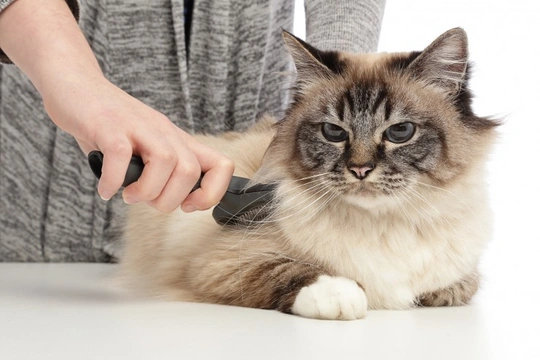
Six good reasons for regularly grooming your cat
If you own a longhaired cat, grooming them is a necessity in order to keep their fur knot-free and in good condition, and to keep them from getting matted fur that may eventually need to be clipped off if it cannot be worked out manually! However, this phenomenon is not unique to longhaired cats, and although it is often overlooked, grooming cats with short fur that does not get knotted or tangled up on its own is a good idea too.
In this article, we will cover six good reasons for regularly grooming your cat, whether your favourite feline is a pampered Persian or a much-loved moggy. Read on to learn more!
Keeping the fur knot-free and in good condition
First of all, the most obvious reason for why grooming your cat regularly is a good idea is of course to keep their fur in good condition, and to keep it from getting tangled up and knotted over time. Whether your cat has long or short fur, giving them a brush out and comb over just once a week can help to ensure that they do not get knotty, tangled or matted fur, particularly in problem areas like between the legs and armpits, and under their tummy, which you might not be able to access very easily!
Stimulating healthy skin and fur
As well as working out knots and helping to prevent your cat’s fur from getting knotted up, brushing the coat actually stimulates the skin itself, which helps to boost circulation and keep the fur and skin healthy. Maintaining a healthy circulation to the skin means that your cat’s coat will be shinier and in better condition, and less apt to become dull and dry.
Grooming your cat also helps to spread the natural oils that keep your cat’s fur sleek and in good condition and helps to protect them from the elements along the hair from root to tip, once more improving both their general condition and health too!
Keeping shed hair to a minimum
Grooming your cat regularly can help to reduce the amount of hoovering up after them that you will need to do! While cats do not shed as heavily as dogs as a general rule, and will not make such a mess of your home as a large, double-coated dog blowing their coat will, cat hair still accumulates throughout the home, in corners, on the furniture, and of course, on your cat’s own bedding!
Brushing them to remove loose hair regularly can keep the amount of cat-hair tumbleweeds rolling around your home to a minimum!
Checking for lumps and bumps
Brushing, grooming and generally paying attention to your cat’s skin, body and fur gives you a valuable opportunity to check your cat over for signs of any problems, which you will be more likely to spot if you have already become familiar with your cat’s norms thanks to regular grooming.
Small but common problems like fleas, ticks and mites can all be identified early on thanks to grooming your cat, and if your cat has any other odd lumps or bumps, such as from a fight with another cat or even a tumour developing, the sooner you can spot the, and get them checked out, the better.
Making your cat more comfortable with handling
Cats tend to be very finicky about how they like to be stroked and handled, having favourite spots and also, no-go areas! It is wise to get your cat used to being handled, picked up, examined and groomed even in places that they aren’t that keen on, as this will make life a lot easier if your cat needs veterinary treatment, and also, to help your vet to be able to examine your cat thoroughly without having a fight on their hands!
If your cat gets particularly annoyed about being groomed in certain areas-such as their tummy-your brush strokes may be a little too firm, or the brush itself too hard-don’t persevere, but instead try lighter strokes, or a different brush that is more gentle.
Strengthening your bond
Sitting down with your cat to give them a mini makeover and pay them some attention is one of the best ways to build and strengthen the bond between you, and grooming should be something that your cat actively enjoys and looks forwards to, rather than something to dread!
Ideally, your cat should actively look forwards to their regular grooming sessions and be keen to come to you to be brushed, so do everything that you can to make the experience pleasant, relaxing and rewarding for your cat, and never try to pin them in a corner, force them to tolerate brushing, or get into a struggle over it-try bribery with some treats, and be prepared to spend some time getting your cat used to brushing slowly, with just a couple of minutes at a time at first.



